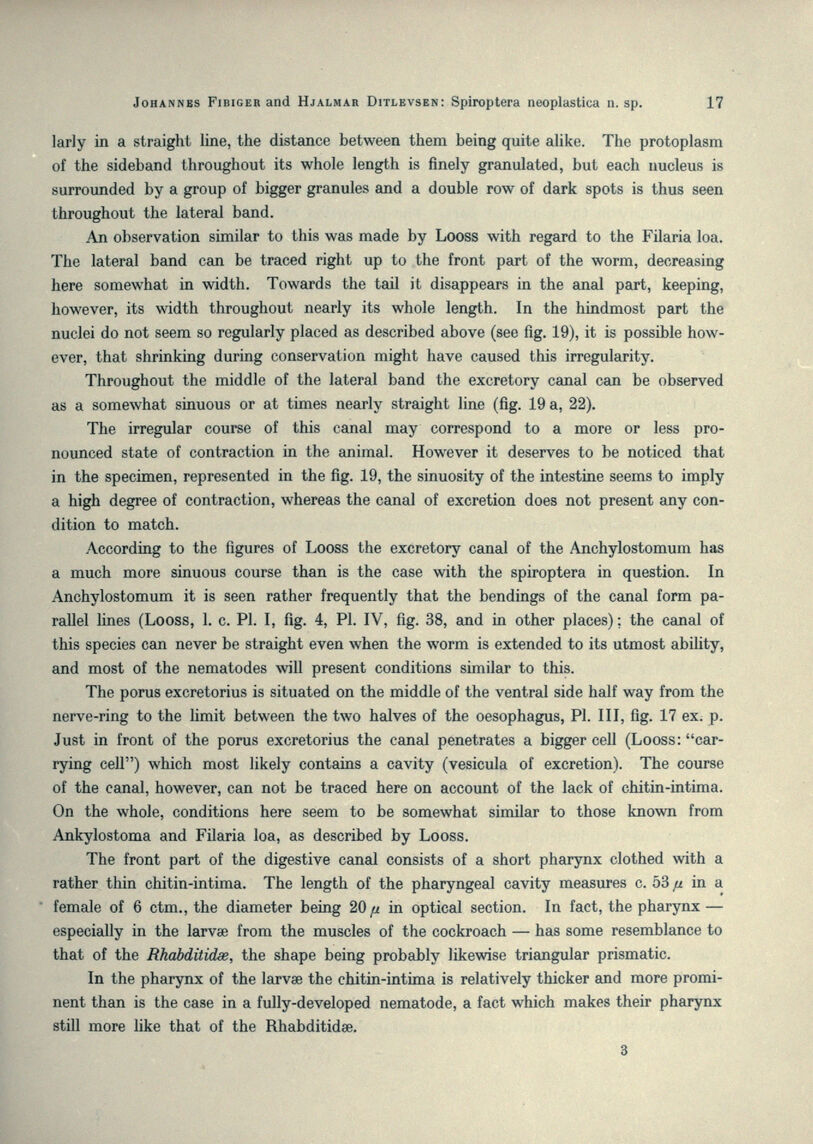
Full resolution (JPEG) - On this page / på denna sida - Contributions to the Biology and Morphology of Spiroptera (Gongylonema) Neoplastica n. sp.

<< prev. page << föreg. sida << >> nästa sida >> next page >>
Below is the raw OCR text
from the above scanned image.
Do you see an error? Proofread the page now!
Här nedan syns maskintolkade texten från faksimilbilden ovan.
Ser du något fel? Korrekturläs sidan nu!
This page has never been proofread. / Denna sida har aldrig korrekturlästs.
larly in a straight line, the distance between them being quite alike. The protoplasm
of the sideband throughout its whole length is finely granulated, but each nucleus is
surrounded by a group of bigger granules and a double row of dark spots is thus seen
throughout the lateral band.
An observation similar to this was made by Looss with regard to the Filaria loa.
The lateral band can be traced right up to the front part of the worm, decreasing
liere somewhat in width. Towards the tail it disappears in the anal part, keeping,
however, its width throughout nearly its whole length. In the hindmost part the
nuclei do not seem so regularly placed as described above (see fig. 19), it is possible how-
ever, that shrinking during conservation might have caused this irregularity.
Throughout the middle of the lateral band the excretory canal can be observed
as a somewhat sinuous or at times nearly straight line (fig. 19 a, 22).
The irregular course of this canal may correspond to a more or less pro-
nounced state of contraction in the animal. However it deserves to be noticed that
in the specimen, represented in the fig. 19, the sinuosity of the intestine seems to imply
a high degree of contraction, whereas the canal of excretion does not present any con-
dition to match.
According to the figures of Looss the excretory canal of the Anchylostomum has
a much more sinuous course than is the case with the spiroptera in question. In
Anchylostomum it is seen rather frequently that the bendings of the canal form pa-
rallel lines (Looss, 1. c. PI. I, fig. 4, PI. IV, fig. 38, and in other piaces) ; the canal of
this species can never be straight even when the worm is extended to its utmost ability,
and most of the nematodes will present conditions similar to this.
The porus excretorius is situated on the middle of the ventral side half way from the
nerve-ring to the limit between the two halves of the oesophagus, PI. III, fig. 17 ex. p.
Just in front of the porus excretorius the canal penetrates a bigger cell (Looss: "car-
rying cell") which most likely contains a cavity (vesicula of excretion). The course
of the canal, however, can not be traced here on account of the lack of chitin-intima.
On the whole, conditions here seem to be somewhat similar to those known from
Ankylostoma and Filaria loa, as described by Looss.
The front part of the digestive canal consists of a short pharynx clothed with a
rather thin chitin-intima. The length of the pharyngeal cavity measures c. 53 // in a
female of 6 ctm., the diameter being 20// in optical section. In faet, the pharynx —
especially in the larvæ from the muscles of the cockroach — has some resemblance to
that of the Rhabditidæ, the shape being probably likewise triangular prismatic.
In the pharynx of the larvæ the chitin-intima is relatively thicker and more promi-
nent than is the case in a fully-developed nematode, a faet which makes their pharynx
still more like that of the Rhabditidæ.
<< prev. page << föreg. sida << >> nästa sida >> next page >>